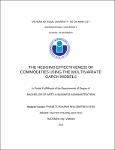| dc.description.abstract | The goal of this research project was to develop hedging strategies for the four commodities coffee, wheat, oil and gold using their spot and future prices. The prime purpose of a hedging strategy then is to find that ratio of the futures position relative to the spot position, such that it yields on the optimal outcome. This is what is termed the optimal hedge ratio – the strategic variable of this research. This research investigates the hedging effectiveness of commodity prices in US by employing various hedge ratio estimation methods, which comprises of the conventional OLS, VECH, BEKK and CCC-GARCH models. First of all, the variance of four methods is compared with each others, and the results shows that the multivariate GARCH have the greatest in minimum variance hedge. Moreover, the empirical results indicate that oil provides the highest hedging effectiveness in four commodities and the second highest hedging effectiveness is gold in all four models. It is also shown that oil provides the most effective hedge for all hedge ratio estimation models compared to other commodities. The results also indicate that the multivariate CCC-GARCH and VECH-GARCH models performs most effectively in four methods. Thus, based on the findings, the CCC and VECH models could serve as a better hedging model than other static and time-varying models in a direct hedge using future prices. | en_US |


